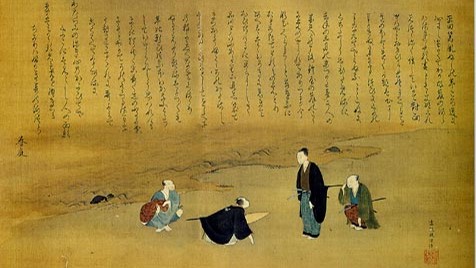Why did Hirata Atsutane Work on Japanese Language Research?

Question: 4 July for the USA, 1 October for China and 14 July for France. Then what about Japan?
The answer is 11 February, National Day of Japan. 4 July is Independence Day of the US, 1 October is National Day in China, which is commemorated in Tiananmen Square, and 14 July is Revolution Day in France, when a grand military parade is held in Paris. In Japan, the Chronicles of Japan(Nihon Shoki) tells us that Emperor Jinmu ascended to the throne on New Year’s Day, 660 BC. It is extremely rare that an event that occurred more than 2,000 years ago is still observed as a holiday. The Kashihara Shrine (located in Nara Prefecture) is now built at the Kashihara Palace where Emperor Jinmu ascended to the throne, and an annual event called the Kigen Sai is held on 11 February. Although our country’s National Day is not as exciting as the other countries, it is still an important day for us. In my previous blog, I wrote about Yanagida Kunio, who deeply loved Japan’s folk history, and I also briefly introduced Nikolai Nevsky, a Japanologist from across the sea.(The Year of the Snake and Kunio Yanagida) In this blog, I would like to continue to focus on the culture of our country.
If you are a member of our institute’s membership service ‘Takeo Harada Gemeinschaft’, you may be familiar with the name ‘Hirata Atsutane’. He often appears in our audio reports. Hirata Atsutane was born on 14 August 1776 in Kubota castle town, Akita, Dewa Province (Akita Prefecture), the fourth son of an Akita feudal lord. Later, in 1795, he left Akita for Edo and was adopted by the Hirata, a military scholar of the Yamaga school of the Bicchu Matsuyama clan.
(Image1: Hirata Atsutane)

(Reference: Wikipedia)
At the time, the Russians had begun to contact Japan, and it is said that the idea of how Japan should defend itself against this threat led him to the writings of the Japanese scholar, Motoori Norinaga. Atsuin Hirata was so impressed by the books of Norinaga that he longed to become his disciple, but Norinaga died when Atsuin Hirata was in his twenties. Strangely enough, after Norinaga’s death, Hirata Atsutane is said to have received permission from him in a dream to become his pupil, and to have devoted himself to the study of Japanese studies. Although it was only a dream, he later sent a letter to Motoori Haruniwa in 1805, and officially became a student of Suzuya.
(Image2: Mysterious encounter of Hirata Atsutane and Motoori Norinaga in a dream.)

(Reference: Wikipedia)
Hirata Atsutane is said to have studied the Kojiki (Records of Ancient Matters) as represented by Motoori Norinaga, the Chronicles of Japan, shrine celebrations (Norito), ancient histories and legends not mentioned in these, Dutch studies (including astronomy), Buddhism, and even the Old Testament in order to understand Christianity. Hirata Atsutane, known as a national scholar, Shintoist, thinker and doctor in the late Edo period, was known for his wide range of specialisations. It is also known that in his later years he also studied the Jindai script, which is believed to have existed before the kana script, and that he also focused on ancient Indian history, Latin and other languages. Now, the question arises. How did he end up studying languages in his later years when he was an ‘expert’ in a very wide range of fields?
The other day, while browsing through the March 2025 issue of Nikkei Science, I came across an article on language. The article described some interesting features of the Murrinh-Patha language, spoken by the majority of the town of Wadiye in north-west Australia, where lives approximately 2,500 people. Its main characteristics are (1) that it is a ‘bicomposite’ language, meaning that it can express four things in a single word: an action, the participants involved in that action and situation, ownership relations and intentions, and (2) that it is free in word order. Free word order means that it does not matter in which order the subject, verb and object are arranged in a sentence. The journal delved into these linguistic features in detail and also referred to whether or not the linguistic processing mechanism is universal.
(Image3: Nikken Science)

(Reference: Amazon)
It stated that “their culture and worldview are so fully embedded in the Murrinh-Patha language that the Murrinh-Patha language is an integral part of their community.” This statement caught my attention. Indeed, “each language is a unique expression of the local people’s experience and contains invaluable knowledge about the earth and people. And each language carries within it the traces of thousands of people from the past. Moreover, each language reveals how the cognitive processes of its speakers interact with the structure of the language [p.36].” It would be natural to say so, but Hirata Atsutane’s linguistic research mentioned above may be because he thought that the elucidation of our language, Japanese, would lead to the elucidation of our Japanese psyche.
All human brains are of course the same, but when people put thoughts into words, their cognitive processing processes may differ depending on the language they are using. Lupien, a psychology professor at the University of Wisconsin-Madison, also says that “language shapes how we construct and perceive how we think about the world [p. 40,41]”. Furthermore, the word order of language is a classification system, and language draws us into those systems. In other words, they lead us to certain ways of classification that are different from other ways of classification. For speakers of different languages, many of these categories are imprinted as basic units of thought, so multilingual speakers can be said to be diverse in the way they think. Culture shapes language because things that are important to a culture are often embedded in that language. Sometimes they are embedded as words, sometimes they are incorporated into the grammar. On the other hand, it is also true that language can shape the role consciousness and thinking of its speakers in different ways. Language and culture form indeed many feedbacks in a large ‘circle’.
In this blog, I picked up the topic of Japanese studies and the study of Japanese language through Hirata Atsutane. In addition, I wrote the connection between language and culture. Unravelling the Japanese language, the mother tongue of the ‘Japanese’, will surely lead to a deeper understanding of the spirit of the people who live there. What are your thoughts on the relationship between language and culture?
・
【References】
[Nikkei Science 25], “Nikkei Science, March 2025 – Words Make the World –”, Nikkei Marketing Strategy, (2025).
※The statements in this blog are not the official views of the Institute, but rather the personal views of the author.
Chancellery Unit, Group for Project Pax Japonica, Maria Tanaka



